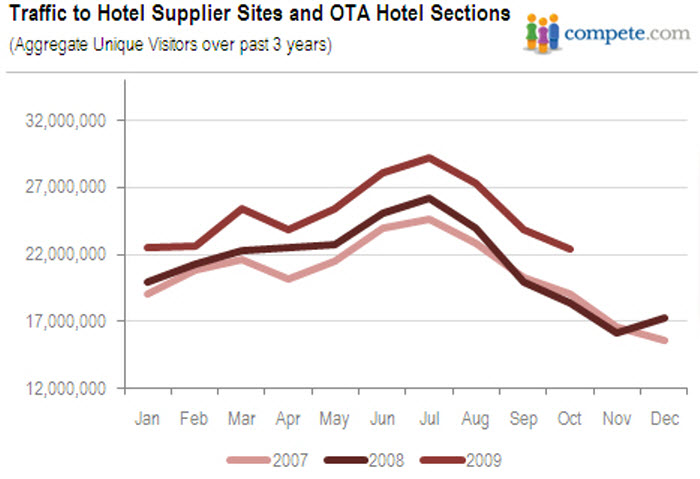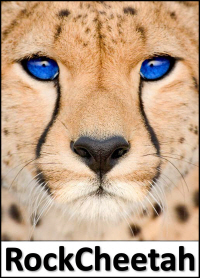Compete recently presented a report based on data through September 2009, concluding that different travel categories (hotel, cruise, air, car rental) have recovered at different rates. Hotels and cruises were highlighted as recovering more quickly than airlines and car rental.

US Hotels are having to jump through hoops to fight competitors and Online Travel Agencies for leisure customers seeking unprecedented deals
It may give some comfort that year-over-year website traffic is increasing in the travel sector. Understanding that this is normally considered a leading indicator, this could serve as a basis for optimism. Unfortunately, for the US hotel industry, increased website traffic has not translated into incremental bookings and the business transacted online is at dramatically lower average rates.
Compete’s panel of Two Million US internet users should hypothetically provide a statistically significant barometer for the US hotel activity levels and would ideally correlate well with the performance of the US hotel industry. Unfortunately, it does not. The US hotel industry is a complex, multi-dimensional vertical that sources business through a variety of distinct market segments and distribution channels.
What the analysis captured was a radical change in consumer hotel travel shopping practices in light of a deep economic recession. Several different factors contributed to the disruptive change impacting the US hospitality industry that emerged in November 2009 and has continued over the past year:
- First, the economic downturn created a flight to value. This resulted in more aggressive comparison shopping behavior as consumers sought the best price available for the hotels under consideration in a particular destination. A January 2009 Compete / Google study revealed that 16% of shoppers considered more than 10 websites when researching travel options.
- A second contributing factor was the policy changes applied by Online Travel Agency (OTA) websites. During 2009, OTAs have progressively removed hotel booking fees and introduced more generous best rate guarantee programs. This helped remove barriers to booking and shifted booking volume from hotel brand websites to OTA sites.
- A third impact has been the growth in meta-search popularity. Travel meta-search sites like Kayak or review sites like TripAdvisor are triggering multiple searches for deals across a large number of hotel brand and intermediary websites. Referral sites are opened in independent windows and would be captured by web analytics as unique visitors for each site.
It is unclear how the relative unique visitor contribution of hotel brand versus OTA websites break out in the Compete analysis, but all indications are that the hotel brands are losing share.
OTA websites trade predominantly in leisure travel. Managed corporate travel is still primarily handled by large travel agency consortia and group travel remains largely negotiated offline and with details coordinated directly with the hotels at the property level. Both the corporate and group market segments have seen steep drops in demand as organizational cost controls eliminate most discretionary business travel. Neither segment, which contribute a substantial portion of the nation’s hotel’s occupancy mix would be reflected in the Compete analysis.
Fundamentally, while Expedia, Priceline.com and Orbitz Worldwide are reaping the benefits of higher site traffic and higher margins from their hotel merchant rate programs, hotel chains like Marriott International, Hilton Worldwide, Starwood Hotels & Resorts Worldwide, Intercontinental Hotels Group, Choice Hotels International and Wyndham Worldwide are not seeing similar success. Case in point, in the 3rd Quarter of 2009, Expedia’s hotel room nights booked increased 24% while the hotel Average Daily Rate (ADR) fell by 14%. In contrast, over the same period, Marriott saw room nights decline 5.6%, while ADR fell by a similar 14.5%.
Due to the parity and enforcement of best rate price guarantees between OTA and hotel brand sites, the benefit of booking via the hotel brand website has been challenged by the convenience of searching and booking on an OTA website. Hotel brand websites have become limited to offering bonus frequent guest points and/or no fees for changes & cancellations as primary differentiators from OTA sites. Under most merchant programs, hotels are also providing discounts ranging from 15% to 35% (up to 70% for opaque product) to the OTAs. The cost is steep, but OTA distribution provides access to a brand indifferent consumer that is otherwise difficult for the hotel brand to reach and convert.

Consumers in search of hotel deals are searching more aggressively by searching more web sites, but the growth in site visits is not translating to increased hotel sales. Supported by deep discounting, cross-channel pricing parity and the elimination of booking fees, OTAs have shifted share from hotel brand websites.
OTAs are monetizing website traffic through advertising, referral fee and transaction based revenue streams. Meanwhile, the hotel companies remain saddled with the challenge of maintaining quality standards while reducing excess headcount and non-essential services. Many hotel owners are deferring repairs & renovations due to imploded real estate valuations on their distressed hotel assets.
To understand the degree of the hoteliers’ plight, one only needs to look at two key statistics: unit-level Net Operating Income (NOI) and the ratio of non-performing Commercial Mortgage Backed Security (CMBS) loans.
PKF Hospitality Research projects a 34.9% decline in unit-level NOI in 2009. This reflects the most dramatic annual decrease in the measure recorded since PKF began tracking US hotel industry performance in the 1930’s. In 2010, US unit level hotel NOI is expected to fall an additional 5.3%.
This historic falloff in income levels has made it impossible for many hotel owners to meet debt service obligations. Currently, the ratio of non-performing Commercial Mortgage Backed Security (CMBS) hotel loans has reached 13.47%, up from 4.31% in June 2009. This is a staggering increase that would imply that the ratio will continue to climb the longer the US hotel recession continues.
While defaults, debt restructuring and hotel real estate transaction volume are all likely to increase, the main question is how these transactions will impact the retail and wholesale pricing strategies of the hotel operations. It is a tall order to raise prices when demand is soft, profits are down and debt service is not being met.
In this environment, hotels can become highly susceptible to the irrational pricing actions of competitors. It is here that the OTAs also contribute to the problem. Opaque travel sites like Priceline and Hotwire (owned by Expedia) aggregate distressed hotel inventory and provide it to consumers seeking deeply discounted rates. Priceline’s “Name Your Own Price” and Hotwire’s “Four-star Hotels at Two-star Prices” tag lines resonate with consumers.
These sites commoditize the hotel product into two-dimensional categories based on location and quality levels. Only a single hotel, typically the one offering the OTA the lowest net room rate is made available for sale in each category. If the hotels want the business, they need to undercut the prices of their competitive-set, and perhaps, hotels in different quality categories or locations that were previously not deemed to be competitors. The OTAs and travelers benefit as consumers are rewarded by the OTAs with big discounts in exchange for their brand indifference.
What should investors seek as a true indicator of a bottom being reached and hints of a US hotel recovery taking place? First, check the Smith Travel Research weekly hotel statistics. The continued negative year-over-year trend in all three key hotel industry metrics – occupancy percentage (Occ%), ADR and revenue per available room (RevPAR) clearly indicates that a bottom has not yet been found.
RevPAR has shown a double digit year over year decline in all but three of the forty-nine weeks recorded thus far in 2009. None of the single digit drops were remotely close to sequential. Some optimistic cheerleaders are forecasting a faster than predicted recovery, but it is difficult to consider a slowing in the rate of decline as the new definition for growth and recovery. This is particularly true when the continued decline is compounding the effect of the precipitous drops of 2008.
It may be an old school approach, but only positive year over year growth percentages should be considered as indicating the foundation for recovery.
US Hotel industry recoveries typically reveal initial increases in Occ%, followed by an increase in ADR as demand improves. During this downturn, the average daily rate has been declining at a greater relative percentage than hotel occupancy over the last six months of 2009. This degree of discounting will make industry rate recovery even more challenging. As a result, it may be more prudent to look for a flattening or increase in RevPAR before ADR begins to recover.
It is important to note that weekly hotel statistics can be impacted dramatically by day of week variations over holiday periods. If the weekly trends are consistent over a four week period, it is highly probable that the trend is authentic. Jumping to early conclusions after seeing sequential performance gains over a two-week period would normally be considered premature unless the increases were significant.
The winter holiday season and beginning of the first quarter traditionally suffers from brutally low seasonal hotel demand. In early 2009, it took until mid-February for average US hotel occupancy to climb above the 50% mark. In earlier years, only the three week period comprising Christmas week through the week following New Years Day ever fell below 50% occupancy on a national basis. Do not be surprised to see 2009 holiday occupancy rates flirt with the 30’s over the next few weeks.
The ultimate outcome is not yet clear, but the morbid jokes including “It is always darkest before it becomes totally black” and “the light at the end of the tunnel is the burning fires of hell” are circulating in hotel investment circles. Perhaps that level of pessimism indicates that a bottom is indeed approaching.
The only relatively good news is that tight financing and poor operating performance will help to inhibit the introduction of new hotel supply into an already saturated national market. One can only hope that hotel demand and pricing will begin to stabilize late in 2010 so the US hotel industry can then focus its efforts on the task of digging itself out of its deeply discounted pricing hole. That is, if the hotel owners have enough patience and deep enough pockets to survive the next 12 months.
One suggestion – Do your part to support the hotel industry. To celebrate the holidays, take a trip, and tell your friends to do the same. Stay in a nice hotel and upgrade to a terrific room. Chances are, once the recovery begins, you may not be able to get deals like these ever again.



